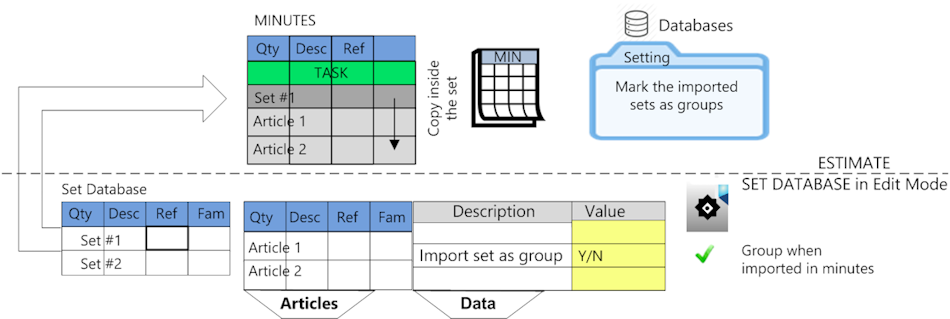Collapsing
The general appearance of the set depends on two boxes in File>Options>Display:
Show new imported sets collapsed |
X |
|
When importing sets, collapse levels as defined in the database |
|
X |
Appearance |
Each set shows as on one row |
The depth below which the rows are hidden is set in Database>Behavior>Collapse when importing * |
* If a nested set belongs to another set database (e.g., set#3 in How to Retrieve the Sources), QDV7 shows the rows up to the higher selected depth level.
Rule of thumb: the option related to the estimate overrides the option related to the database.
As a group |
Not as a group |
|
|
In the Minutes, the rows will be grayed or not and the optional Group header column is populated or not according to
▪for the estimate (Databases>Setting tab), the 'Mark the imported set as group' logic value (refer to How to Create an Empty Database of Sets)
▪on the database level, the 'Group when imported in minutes' logic value (refer to How to Change a Database Behavior)
▪on the set level (Data tab), 'Import sets as group ' logic value (refer to How to Parameterize the Insertion into the Minutes):

Arbitration:
Setting for the estimate devis |
Option of sets database |
Set inserted as |
Activated |
Deactivated |
group |
Activated |
Activated |
group |
Deactivated |
Deactivated |
non group |
Deactivated |
Activated |
group |
The Database behavior logic value is often used when a set database features Nested Sets:
▪the logic value is deactivated in the parent set
▪the logic value is activated in the nested sets.
When you import the parent set in the Minutes, only the nested sets get grouped.
Spreading Values
To spread the header value to the underlying values for a given column, set the Groups>Copy inside set' attribute to Yes for this field in the Manager.
The default value is No.